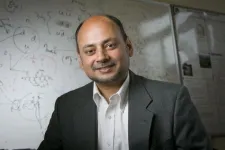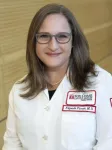(Press-News.org) DURHAM, N.C. -- It sounds fantastical, but it’s a reality for the scientists who work at the world’s largest particle collider:
In an underground tunnel some 350 feet beneath the France–Switzerland border, a huge device called the Large Hadron Collider sends beams of protons smashing into each other at nearly the speed of light, creating tiny eruptions that mimic the conditions that existed immediately after the Big Bang.
Scientists like Duke physicist Ashutosh Kotwal think the subatomic debris of these collisions could contain hints of the universe’s “missing matter.” And with some help from artificial intelligence, Kotwal hopes to catch these fleeting clues on camera, using a design described May 3 in the journal Scientific Reports.
Ordinary matter -- the stuff of people and planets -- is only part of what’s out there. Kotwal and others are hunting for dark matter, an invisible matter that’s five times more abundant than the stuff we can see but whose nature remains a mystery.
Scientists know it exists from its gravitational influence on stars and galaxies, but other than that we don’t know much about it.
The Large Hadron Collider could change that. There, researchers are looking for dark matter and other mysteries using detectors that act like giant 3D digital cameras, taking continuous snapshots of the spray of particles produced by each proton-proton collision.
Only ordinary particles trigger a detector’s sensors. If researchers can make dark matter at the LHC, scientists think one way it could be noticeable is as a sort of disappearing act: heavy charged particles that travel a certain distance -- 10 inches or so -- from the point of collision and then decay invisibly into dark matter particles without leaving a trace.
If you retraced the paths of these particles, they would leave a telltale “disappearing track” that vanishes partway through the detector’s inner layers.
But to spot these elusive tracks they’ll need to act fast, Kotwal says.
That’s because the LHC’s detectors take some 40 million snapshots of flying particles every second.
That’s too much raw data to hang on to everything and most of it isn’t very interesting. Kotwal is looking for a needle in a haystack.
“Most of these images don't have the special signatures we’re looking for,” Kotwal said. “Maybe one in a million is one that we want to save.”
Researchers have just a few millionths of a second to determine if a particular collision is of interest and store it for later analysis.
“To do that in real time, and for months on end, would require an image recognition technique that can run at least 100 times faster than anything particle physicists have ever been able to do,” Kotwal said.
Kotwal thinks he may have a solution. He has been developing something called a “track trigger,” a fast algorithm that is able to spot and flag these fleeting tracks before the next collision occurs, and from among a cloud of tens of thousands of other data points measured at the same time.
His design works by divvying up the task of analyzing each image among a large number of AI engines running simultaneously, built directly onto a silicon chip. The method processes an image in less than 250 nanoseconds, automatically weeding out the uninteresting ones.
Kotwal first described the approach in a sequence of two papers published in 2020 and 2021. In the more recent paper published this May in Scientific Reports, he and a team of undergraduate student co-authors show that his algorithm can run on a silicon chip.
Kotwal and his students plan to build a prototype of their device by next summer, though it will be another three or four years before the full device -- which will consist of about 2000 chips -- can be installed at detectors at the LHC.
As the performance of the accelerator continues to crank up, it will produce even more particles. And Kotwal’s device could help make sure that, if dark matter is hiding among them, scientists won’t miss it.
“Our job is to ensure that if dark matter production is happening, then our technology is up to snuff to catch it in the act,” Kotwal said.
END
A camera trap for the invisible
AI-powered image recognition could give researchers a new tool in the hunt for dark matter
2024-07-29
ELSE PRESS RELEASES FROM THIS DATE:
Neurodivergent children are twice as likely to experience chronic disabling fatigue in adolescence
2024-07-29
The research, led by Dr Lisa Quadt, Research Fellow in Psychiatry at BSMS and Dr Jessica Eccles, Reader in Brain-Body Medicine at BSMS, highlights a significant link between neurodivergence and chronic fatigue. The study found that increased inflammation in childhood, often resulting from heightened stress levels, may be a contributing factor. This supports previous findings that suggest chronic fatigue can be rooted in inflammatory processes.
“These results show the importance of trans-diagnostic screening for children and the need for better support for neurodivergent children” says Dr Quadt. “Children with neurodivergent ...
Engineers use data to manage grid transformers, boosting reliability to homes, farms
2024-07-29
AMES, Iowa – Pay attention the next time you drive near your home, farm or business. You’ll notice small, green utility boxes all over the place. They’re distribution transformers. If they’re not working properly, electricity won’t flow to your lights and appliances.
Those boxes take kilovolts of electricity (that’s high voltage, measured in 1,000s of volts) from transmission lines and step it down to the safer, practical 120 or 240 volts that power our daily lives.
“Utilities have plenty of them,” said Zhaoyu Wang, an Iowa State University professor of electrical and computer engineering. “Most of them only ...
PSU awarded $1.9M NOAA grant to address microplastic pollution in coastal communities
2024-07-29
Portland State University (PSU) has been awarded $1,976,806 from the National Oceanic and Atmospheric Administration's (NOAA) National Sea Grant Marine Debris Challenge Award Program to lead an innovative and collaborative three-year project to address microplastic pollution on the Oregon coast.
This grant is part of a $27 million project between the U.S. Department of Commerce and NOAA. Portland State will host one of 11 projects that received a total of $25 million in funding across Alabama, California, Florida, Illinois, Massachusetts, New York, North Carolina, Oregon, Texas and Wisconsin. These projects ...
Association for Molecular Pathology announces 2024 award recipients
2024-07-29
ROCKVILLE, Md. – July 29, 2024 – The Association for Molecular Pathology (AMP), the premier global molecular diagnostic professional society, today announced the recipients of this year’s Excellence in Molecular Diagnostics, Jeffrey A. Kant Leadership, and Meritorious Service Awards. These prestigious accolades will be presented to the winners this November during AMP’s 2024 Annual Meeting & Expo in Vancouver, British Columbia.
Award for Excellence in Molecular Diagnostics
Atul Butte, MD, PhD
Priscilla Chan and Mark Zuckerberg Distinguished ...
Mutations in DNA damage repair genes associated with response to cisplatin in bladder cancer: Prospective validation from SWOG S1314 trial
2024-07-29
An analysis of pre-treatment tumor specimens from 105 patients with localized muscle-invasive bladder cancer found that the presence of a mutation in any one of three genes, all known to be involved in DNA damage repair, was associated with complete pathologic response to cisplatin-based neoadjuvant chemotherapy as measured by pathological downstaging at the time of bladder surgery. Results are published in the journal European Urology.
“The SWOG S8710 randomized trial provided Level 1 evidence supporting ...
Timber plantations near urbanized areas support the movement of small and medium-sized terrestrial mammals between patches of natural forest
2024-07-29
In the fight to mitigate climate change and deforestation in the tropics, timber plantations have emerged as a promising strategy for reforesting degraded land and connecting patches of natural forest. Often, these are species with commercial value for landowners but are not native to the region. To evaluate how well non-native tree plantations support native wildlife in heavily human-impacted areas, researchers from the Smithsonian Tropical Research Institute (STRI), the Max Planck Institute of Animal Behavior (MPI-AB), Wageningen University & Research, and the University of California – Davis surveyed over 200 hectares of timber plantations ...
Wang receives funding for Experiential Learning Program
2024-07-29
Wang Receives Funding For Experiential Learning Program
Zhengdao Wang, Professor, Cybersecurity Engineering, College of Engineering and Computing (CEC), received $14,000 from Old Dominion Research Foundation for: “CCI—2024 Experiential Learning Program/Water System Infrastructure - Innovative Experiential Learning.”
Wang intends to enhance awareness and understanding of cybersecurity risks associated with public water systems by developing an educational simulation game, "CyberShield H2O."
He will provide ...
Everyday activities aren’t enough to protect against stroke
2024-07-29
Research conducted at the University of Gothenburg shows that the physical activities we do as we go about our lives, at work or in the home, aren’t enough to protect us from having a stroke. However, exercising in our free time and using active modes of transport are associated with a decreased risk of stroke.
“Physical activity during leisure time and as transportation is becoming increasingly important now that many jobs and domestic activities are becoming more sedentary,” says lead ...
Deciphering the role of mitochondrial DNA targeted therapy in hepatic cell carcinoma
2024-07-29
Hepatic cell carcinoma (HCC), the fifth most prevalent malignancy worldwide and the fourth leading cause of cancer-related mortality, poses significant therapeutic challenges. Despite advancements in medical research, late-stage HCC patients have a dismal five-year survival rate of less than 20%. The complexity of liver cancer development involves an intricate interplay of genetic and environmental factors. Among these, mitochondrial alterations and mutations in mitochondrial DNA (mtDNA) are increasingly recognized as critical contributors to cancer pathogenesis. These changes not only impair cellular bioenergetics ...
Projected changes in statin and antihypertensive therapy eligibility with the AHA PREVENT cardiovascular risk equations
2024-07-29
About The Study: By assigning lower atherosclerotic cardiovascular disease risk predictions, application of the Predicting Risk of cardiovascular disease EVENTs (PREVENT) equations to existing treatment thresholds could reduce eligibility for statin and antihypertensive therapy among 15.8 million U.S. adults.
Corresponding Author: To contact the corresponding author, Arjun K. Manrai, Ph.D., email Arjun_Manrai@hms.harvard.edu.
To access the embargoed study: Visit our For The Media website at this link https://media.jamanetwork.com/
(doi:10.1001/jama.2024.12537)
Editor’s ...
LAST 30 PRESS RELEASES:
Air pollution exposure and birth weight
Obstructive sleep apnea risk and mental health conditions among older adults
How talking slows eye movements behind the wheel
The Ceramic Society of Japan’s Oxoate Ceramics Research Association launches new international book project
Heart-brain connection: international study reveals the role of the vagus nerve in keeping the heart young
Researchers identify Rb1 as a predictive biomarker for a new therapeutic strategy in some breast cancers
Survey reveals ethical gaps slowing AI adoption in pediatric surgery
Stimulant ADHD medications work differently than thought
AI overestimates how smart people are, according to HSE economists
HSE researchers create genome-wide map of quadruplexes
Scientists boost cell "powerhouses" to burn more calories
Automatic label checking: The missing step in making reliable medical AI
Low daily alcohol intake linked to 50% heightened mouth cancer risk in India
American Meteorological Society announces Rick Spinrad as 2026 President-Elect
Biomass-based carbon capture spotlighted in newly released global climate webinar recording
Illuminating invisible nano pollutants: advanced bioimaging tracks the full journey of emerging nanoscale contaminants in living systems
How does age affect recovery from spinal cord injury?
Novel AI tool offers prognosis for patients with head and neck cancer
Fathers’ microplastic exposure tied to their children’s metabolic problems
Research validates laboratory model for studying high-grade serous ovarian cancer
SIR 2026 delivers transformative breakthroughs in minimally invasive medicine to improve patient care
Stem Cell Reports most downloaded papers of 2025 highlight the breadth and impact of stem cell research
Oxford-led study estimates NHS spends around 3% of its primary and secondary care budget on the health impacts of heat and cold in England
A researcher’s long quest leads to a smart composite breakthrough
Urban wild bees act as “microbial sensors” of city health.
New study finds where you live affects recovery after a hip fracture
Forecasting the impact of fully automated vehicle adoption on US road traffic injuries
Alcohol-related hospitalizations from 2016 to 2022
Semaglutide and hospitalizations in patients with obesity and established cardiovascular disease
Researchers ‘listen in’ to embryo-mother interactions during implantation using a culture system replicating the womb lining
[Press-News.org] A camera trap for the invisibleAI-powered image recognition could give researchers a new tool in the hunt for dark matter




